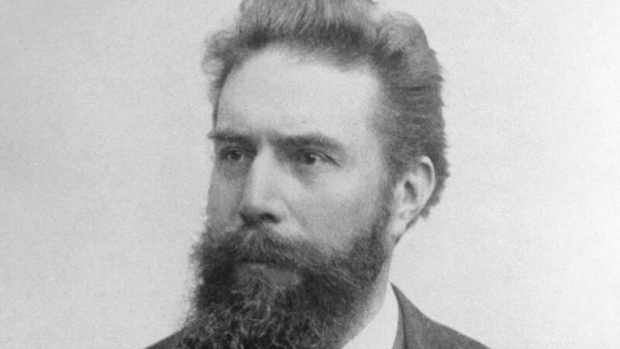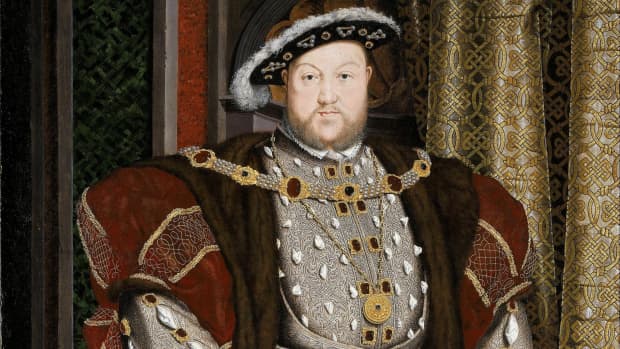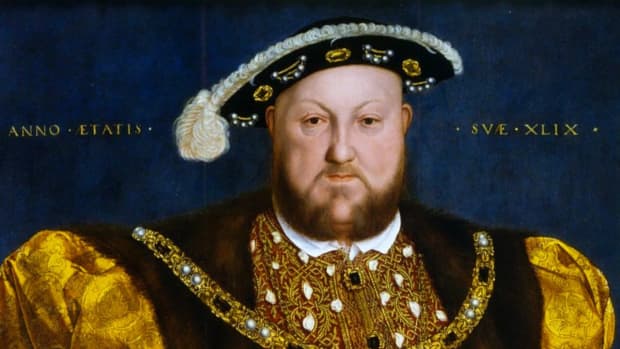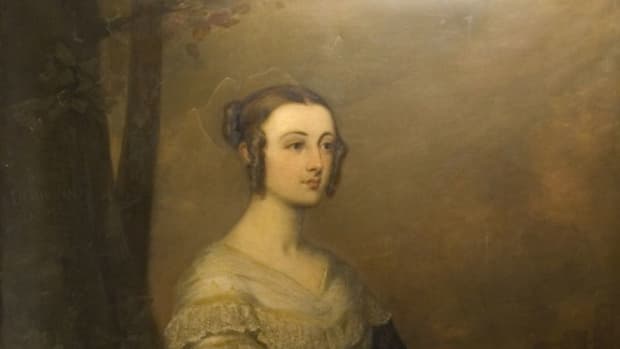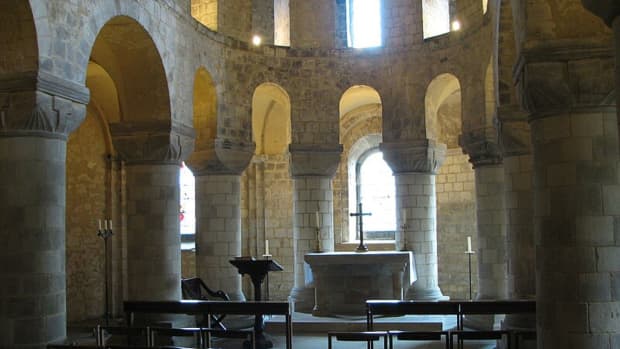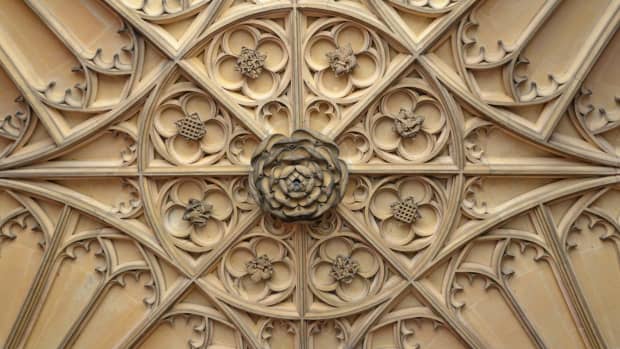Lady Jane Grey's Claim to the Tudor Throne
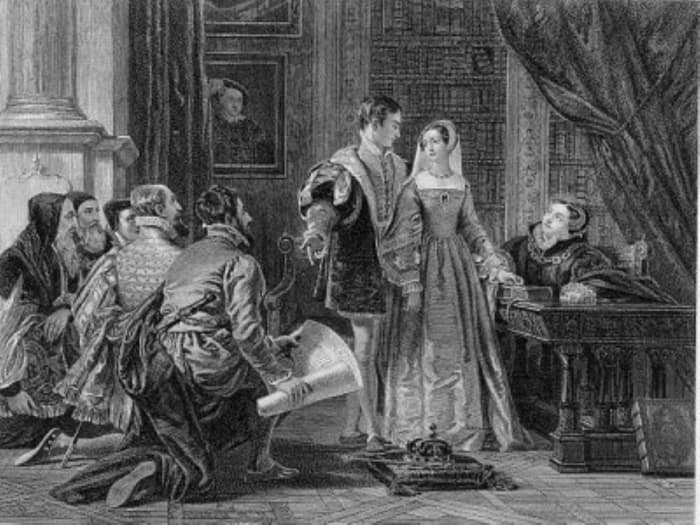
"The Crown Offered to Lady Jane Grey," an 1820s imagining of the moment she became Queen Jane.
Public domain via Wikipedia
Henry VII's Descendants
Lady Jane Grey’s claim to the throne of Tudor England came from her great grandfather King Henry VII, father of Mary Tudor, who was a sister of Henry VIII. Mary’s second and secret marriage with Charles Brandon, 1st Duke of Suffolk, was carried out in 1515. Henry VIII eventually forgave the couple for marrying without his consent, but only after they paid him a substantial fine.
Their marriage brought four children and their eldest daughter, Frances, married Henry Grey, 3rd Marquess of Dorset, in 1533. Frances and Henry Grey had three daughters; the eldest of these was Lady Jane, born in Leicester in 1537. Henry Grey was made the Duke of Suffolk in 1551.
Jane and her sisters, Catherine and Mary, were educated well and were raised to make advantageous marriages with noblemen who would be worthy of securing a royal descendant.
King Edward VI to Marry Lady Jane Grey?
Aged ten Jane was sent to live with Edward VI’s maternal uncle Thomas Seymour. Seymour had enjoyed a significant rise in status throughout and after his late sister Jane’s short-lived union with Henry VIII. By spring 1547 Thomas was married to Catherine Parr, Henry’s sixth wife and widow.
King Henry had only died on the 28th January that year. Catherine died in childbirth in 1548 and Thomas was executed for treason by Edward in 1549 after his unsuccessful scheme to marry Jane to Edward was discovered. This plot had been supported by Jane’s father but Edward did not punish Henry Grey.
Grey arranged for rewarding unions between his and three other important families. There was a double wedding in May 1553 of Jane to Guildford Dudley, heir to John Dudley, Duke of Northumberland who was Edward VI’s regent, and of Katherine Grey to Henry Herbert, the heir of the 1st Earl of Pembroke. Mary Grey was betrothed to her cousin Arthur Grey, heir to the 13th Baron Grey de Wilton.
Tudor Heirs
When it became apparent that King Edward’s health was failing fatally, Northumberland took his opportunity to promote Jane, his new daughter-in-law’s interests in the throne. She was a Tudor descendant of protestant stock who would be highly preferable to catholic Mary Tudor, once declared illegitimate by Henry VIII.
The country was in the midst of a protestant reformation and Edward was uncomfortable about what England would face if Mary ascended the throne. Jane was a devout protestant. The king changed his succession document to show that Jane and her descendants and not Mary or his other half-sister Elizabeth would be his heirs. Jane was sensible and most importantly for Northumberland, who was far more interested than Jane in claiming the crown, malleable.
Queen Jane Grey (Dudley): July 1553
On the 6th July 1553, Edward VI died. Jane was crowned queen on the 10th July thanks to Northumberland’s engineering and with her parents' full agreement. The Mayor of London also proclaimed that Jane was the rightful queen.
Recommended
Fifteen-year-old Jane initially fainted at the idea of ruling but she dutifully complied with her elders' wishes. She soon grew into the role of queen and then became overconfident as an excess of power in her teenage hands swamped her natural intelligence and secured disaster.
Although she convinced herself that she was the rightful and, vitally, protestant queen of England, the great and good who at first willingly acknowledged Jane’s claim and hoped to save Protestantism's dominance swiftly became disaffected. Northumberland wielded the power and not Jane and he was hugely unpopular with the public.
Queen Mary I Ousts Jane
Mary, for all her perceived faults, was championed by the people as the true heir named by Henry VIII as Edward’s successor. An army of her supporters swept with her towards London to remove Jane.
As the hours of Jane’s reign passed and hope ebbed away her father deserted her. He declared himself to be on Mary’s side but he was understandably suspected of not being even slightly loyal to Mary but wholly dedicated to saving his own life. He implored Jane to surrender.
Mary I and her army supplanted Jane on the 19th July. Her tumultuous nine-day reign was over. England was to be a catholic country for the next five years.
After Jane's Nine Day Reign
- Jane and Guildford Dudley were incarcerated in the Tower of London. They were found guilty of treason but Mary did not have them executed when their sentences were passed down. Perhaps she considered that they, Jane in particular, were pawns in Northumberland’s grand scheme. However, Jane did herself no favours when she opposed the return of Catholic masses ordered by Mary.
- Northumberland was tried for high treason and was duly executed on the 22nd August 1553.
- Mary Grey’s betrothal to Arthur Grey was cancelled after Jane’s nine-day reign.
- Katherine’s marriage to Herbert was annulled in light of the failed coup.
- In early 1554 Henry Grey, Duke of Suffolk, confirmed his queen’s doubts about his faithfulness when she discovered his participation in Sir Thomas Wyatt’s plot to overthrow her. After the Wyatt plot’s failure the queen drew the conclusion that for as long as Henry Grey, Guildford Dudley and her cousin Jane remained alive they posed a threat to her.
- Early on the 12th February 1554, Guildford Dudley was executed at the Tower of London, and Jane's execution was two hours later. In her final address to onlookers, Jane attested that she had violated the law in Mary’s England but she had never violated God’s laws.
- Henry Grey, Duke of Suffolk was executed on the 23rd February 1554. He was 37 years old.
- Jane’s mother Frances Brandon surrendered her lands and wealth to the queen and she, with daughters Katherine and Mary, feigned conversions to the catholic faith. This move gained Frances the return of some of her lands. She remarried in 1555 and wisely stayed away from the royal court. Mary followed her mother’s lead but Katherine was a regular visitor at court. Frances passed away in November 1559, just a year after Mary I’s death.

The Chapel of St. Peter ad Vincula at the Tower of London where Lady Jane Grey and Guildford Dudley were laid to rest. (Jane is said to haunt the location).
Michael Coppins/Wikipedia CC4.0
Mary I, known to history as Bloody Mary thanks to her persecution of protestants, had no power to halt Jane’s rise as a protestant martyr and her status as the tragic Nine Days' Queen in English and Tudor history. You might argue that Jane is better and more fondly remembered than her cousin Mary Tudor.
Sources
- Lady Jane Grey – Death, Facts & Life | Biography.com
- Frances Brandon – Daughter of the French Queen (Part Two) | History of Royal Women
- Lady Jane Grey – Biography, Facts, & Execution | Britannica
This content is accurate and true to the best of the author’s knowledge and is not meant to substitute for formal and individualized advice from a qualified professional.
© 2022 Joanne Hayle



